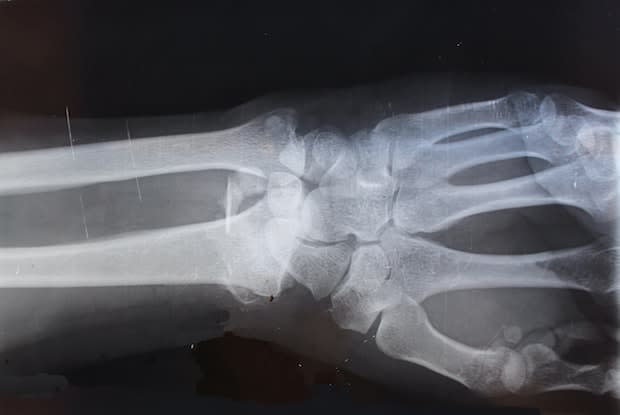Table of Contents
Arthritis Overview
Arthritis is an extremely common condition that affects millions of Americans. The Centers for Disease Control estimates that 23 percent of adults in the United States have a form of arthritis. Arthritis is one of the leading causes of work disability and can severely affect a person’s life if left untreated. This disease can limit the amount of work you can do and impair the ability to climb stairs or walk around. [1]
This inflammatory disorder involves swelling and tenderness of the joints. People usually feel pain and stiffness with the two most common arthritis types: osteoarthritis and rheumatoid arthritis. General symptoms of arthritis can include:
- Pain
- Stiffness
- Redness
- Decreased range of motion
Most commonly, severe arthritis affects the hands, arms, and hips. Arthritis in these areas of the body can prevent you from walking comfortably, and these joints may become twisted and gnarled over time. Luckily, there are several types of medications available to combat arthritis symptoms. These medications can include Mobic (meloxicam), indomethacin (also available in indomethacin suppositories), Celebrex (celecoxib), and Medrol (methylprednisolone). [2]
There are over 100 different types of joint pain that may affect a person. The type of arthritis you have will have specific treatments. Arthritis can affect anyone, from children to older adults. Read below for the most common forms of this joint disease. OA is a wear and tear joint disease and involves the breakdown of cartilage in the joints. The bones then rub together, leading to pain and discomfort. It may also cause the joints to become inflamed and lead to bone injury and bone spur formation. Most people with OA develop it as they grow older and their joints age. Mobic (meloxicam) and indomethacin are medications used in the treatment of osteoarthritis. You may experience the following symptoms with OA: Rheumatoid arthritis differs from wear and tear arthritis because it is an autoimmune condition. Autoimmune conditions occur when the immune system mistakenly attacks healthy parts of the body. The immune system attacks joint tissue in the case of RA. This disease affects over 1.5 million adults in America. Autoimmune conditions are typically genetic and may affect other parts of the body. If you have one immune system problem, you are also much more likely to develop other autoimmune conditions. Symptoms of RA can include: Arthritis is not just for older people; it can also occur in young children and teenagers. Juvenile arthritis is the most common form of arthritis in people under 16 years old. It is also an autoimmune disorder, and the body attacks its cells and tissues. Juvenile arthritis may occur due to genetic and environmental factors. Over time, this disease can lead to joint damage, eye inflammation, and growth problems. If your child is experiencing abnormal joint pain, you should consult your child's pediatrician. Symptoms of juvenile arthritis can include: Thumb arthritis is related to osteoarthritis and is more likely to occur as a person ages. This type of arthritis occurs when the cartilage wears away from the end of the bones that form the joint at the thumb's base. Once this cartilage is worn away, it may not be easy to perform simple everyday tasks, like opening doorknobs and jars. If your thumb arthritis becomes severe, you may require surgery to improve strength and range of motion. Aging, trauma, and injury are the most common causes of thumb arthritis. Symptoms of this condition include: If you notice that you are experiencing joint pain, you should seek the help of your doctor. Initially, your doctor will take fluid tests to analyze your blood, urine, and joint fluid. To get joint fluid, your doctor will insert a needle into the joint and withdraw fluid. If the joint fluid shows signs of arthritis, you may also undergo x-rays to show cartilage loss and bone damage. Once an x-ray is taken, you may also get a CT (computerized tomography) or an MRI (magnetic resonance imaging) to get more detailed images of your affected joints. If necessary, an ultrasound will be done so your doctor knows where to insert a needle into the joint for corticosteroid medication injections. [2] As mentioned earlier, there are many medications available for the treatment of arthritis. NSAIDs (nonsteroidal anti-inflammatory drugs) are commonly used for arthritis to reduce pain and inflammation. Mobic (meloxicam), indomethacin, and Celebrex (celecoxib) are all NSAIDs but should be taken with caution because they can cause stomach irritation and increase your heart attack risk and stroke. It is best to take this drug with food and a full glass of water to prevent stomach upset. Corticosteroids are also used to treat joint pain and inflammation. These drugs can be taken orally or injected directly into the joint that is experiencing arthritis pain. On Canada Med Pharmacy, Medrol (methylprednisolone) is a corticosteroid available for treating arthritis pain. If you have a severe form of arthritis, you may require surgery to repair joint function. [2] The content in this article is intended for informational purposes only. This website does not provide medical advice. In all circumstances, you should always seek the advice of your physician and/or other qualified health professionals(s) for drug, medical condition, or treatment advice. The content provided on this website is not a substitute for professional medical advice, diagnosis, or treatment.
Types of Arthritis
a. Osteoarthritis (OA)
b. Rheumatoid Arthritis (RA)
c. Juvenile Arthritis

d. Thumb Arthritis
Diagnosing Arthritis

Medications & Treatments
